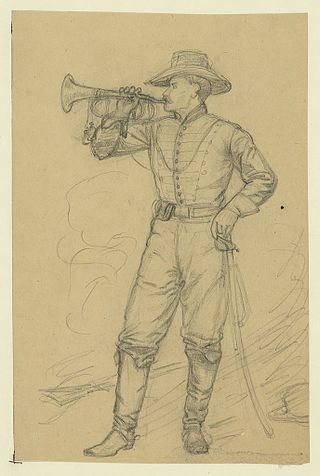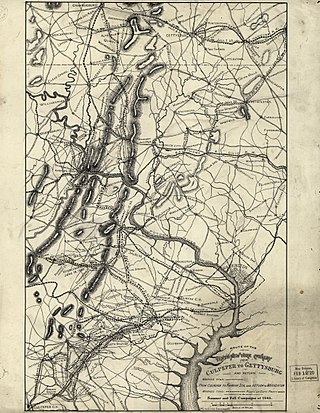
James Parker Landis was an American soldier who served in the Union Army during the American Civil War. He received the Medal of Honor for the capture of a Confederate flag during the Battle of Amelia Springs while serving as the Chief Bugler of the 1st Pennsylvania Cavalry.
The 4th Pennsylvania Cavalry Regiment was a cavalry regiment of the Union Army during the American Civil War.

Alexander Calvin Elliott was a United States soldier who fought with the Union Army during the American Civil War as a sergeant with Company A of the 1st Pennsylvania Cavalry. He received his nation's highest award for valor, the U.S. Medal of Honor, for his actions at Paines Crossroads, Virginia on April 5, 1865. That award was conferred on May 3, 1865.
Andrew Jackson Young was a United States soldier who fought with the Union Army during the American Civil War as a member of Company F of the 1st Pennsylvania Cavalry. He received his nation's highest award for valor, the U.S. Medal of Honor, for capturing a Confederate flag at Paines Crossroads, Virginia, on April 5, 1865. That award was conferred on May 3, 1865.
The 81st Pennsylvania Volunteer Infantry was an infantry regiment that served in the Second Corps, First Division, of the Army of the Potomac during the American Civil War.

The 52nd New York Infantry Regiment was an infantry regiment in the Union Army during the American Civil War.

The 110th Pennsylvania Volunteer Infantry was an infantry regiment that served in the Union Army during the American Civil War.

The 1st Massachusetts Volunteer Cavalry Regiment was a cavalry regiment that served in the Union Army during the American Civil War.

The 10th New York Cavalry Regiment was a cavalry regiment that served in the Union Army during the American Civil War.

The 8th Pennsylvania Cavalry was a cavalry regiment that served in the Union Army during the American Civil War.
The 13th Pennsylvania Cavalry Regiment was a cavalry regiment that served in the Union Army during the American Civil War.

The 16th Pennsylvania Cavalry was a cavalry regiment that served in the Union Army during the American Civil War.
The 88th Regiment, Pennsylvania Volunteer Infantry was an infantry regiment that served in the Union Army during the American Civil War.

The 2nd Pennsylvania Reserve Regiment also known as the 31st Pennsylvania Volunteer Infantry was an infantry regiment that served in the Union Army as part of the Pennsylvania Reserves infantry division during the American Civil War.

The 1st Pennsylvania Reserve Regiment, also known as the 30th Pennsylvania Volunteer Infantry, was a regiment in the Union Army during the American Civil War. It was a part of the famed Pennsylvania Reserve division in the Army of the Potomac for much of the war, and served in the Eastern Theater in a number of important battles, including Antietam, Fredericksburg, and Gettysburg.
The 9th Pennsylvania Reserve Regiment also known as the 38th Pennsylvania Volunteer Infantry was an infantry regiment that served in the Union Army as part of the Pennsylvania Reserves infantry division during the American Civil War.
The 10th Pennsylvania Reserve Regiment also known as the 39th Pennsylvania Volunteer Infantry was an infantry regiment that served in the Union Army as part of the Pennsylvania Reserves infantry division during the American Civil War.
The 6th Pennsylvania Reserve Regiment also known as the 35th Pennsylvania Volunteer Infantry was an infantry regiment that served in the Union Army as part of the Pennsylvania Reserves Infantry Division during the American Civil War.

The 61st Regiment, Pennsylvania Volunteer Infantry was an infantry regiment that served in the Union Army during the American Civil War.
The 82nd Pennsylvania Volunteer Infantry was an infantry regiment that served in the Union Army during the American Civil War. It was designated the 31st Pennsylvania Volunteer Infantry until after the Battle of Seven Pines but changed to avoid confusion with the 2nd Pennsylvania Reserve Regiment, which was renumbered.











